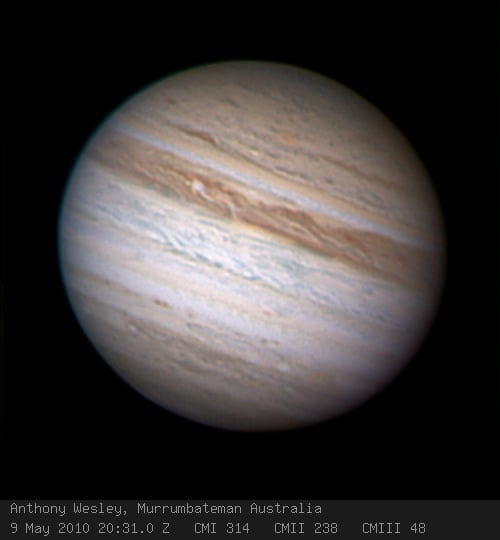[/caption]
Jupiter's appearance has changed dramatically since the end of 2009, when it moved too close to the Sun from our vantage point on Earth to be observed. New looks at the planet after it emerged from the Sun's glare reveals that one of the bands of clouds, the South Equatorial Belt, has gone missing. This image from amateur astronomer
Anthony Wesley
(
the same astronomer who captured an impact spot on Jupiter last year)
taken on May 9, 2010, shows a rather undressed Jupiter without its usually prominent southern band. See a comparison of earlier images below.
[caption id="attachment_64325" align="aligncenter" width="500" caption="Dramatic changes in Jupiter from less than a year ago. The South Equatorial Belt (SEB) has faded away leaving just the north belt (NEB) viewable in small telescopes. Credit: Anthony Wesley, caption via Bob King"]
[/caption]
What caused the disappearance of the band? Astronomers aren't sure, but this isn't the first time this has happened. Back in 1973 when the Pioneer 10 spacecraft flew by and took the first close-up images of the planet, the southern band was missing, and it also disappeared in the early 1990s. Also, in 2007 cloud bands around its equator that had been light-colored for the past 15 years or so were noticeably darker.
Emily at the Planetary Society has written about this
, and so has amateur astronomer
Bob King, a.k.a "Astro Bob
," who explains:
"Every 3-15 years, the belt, which is normally dark reddish-brown in color and typically divided in two by the south equatorial belt zone, fades from view. After some weeks or months a brilliant white spot forms within that zone and begins spouting dark blobs of material which get stretched into filaments and ovals by Jupiter's fierce winds into a new SEB. Within a few weeks (or longer) the belt is back and Jupiter presents its familiar dual "tire track" appearance through a telescope."
Check out
Anthony Wesley's gallery of Jupiter images,
and watch for new images over the next days and months to monitor the changes. Surely, Hubble and other observatories will be making new observations, as well.
Thanks to Anthony Wesley for sharing his images.
 Universe Today
Universe Today
